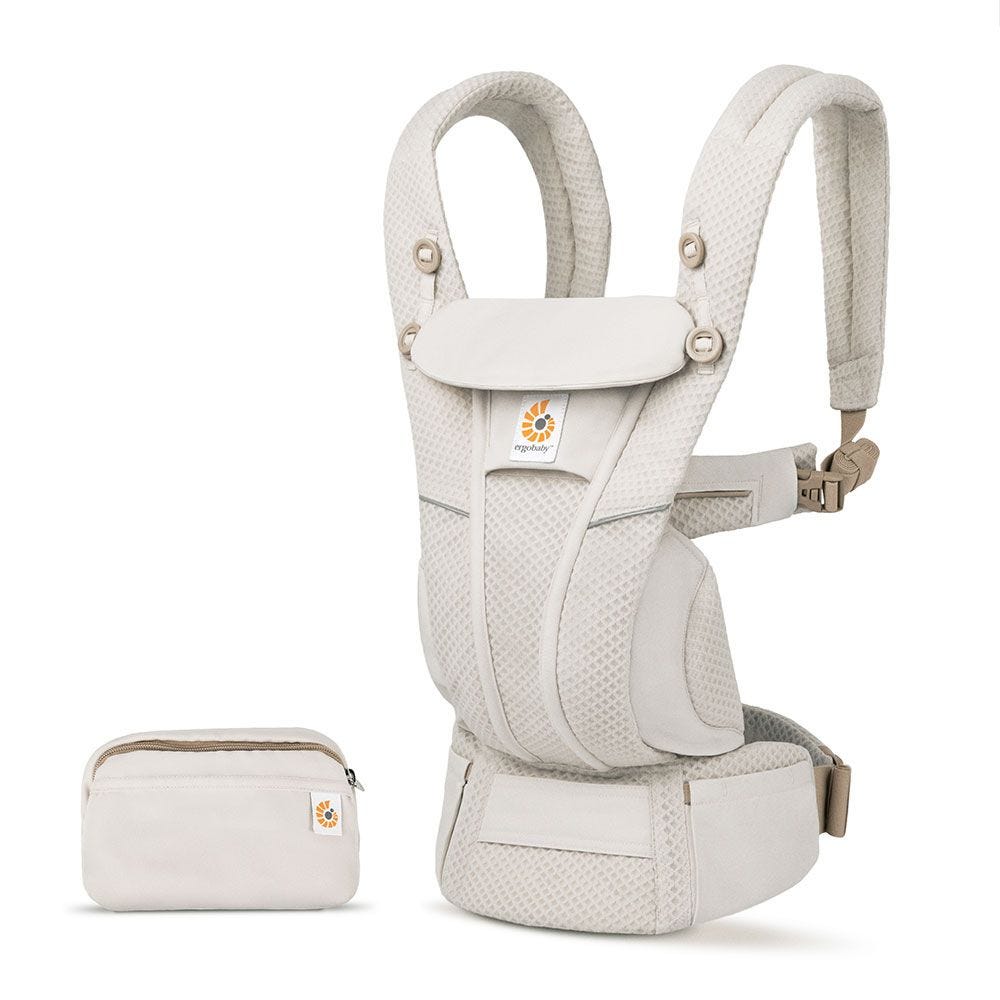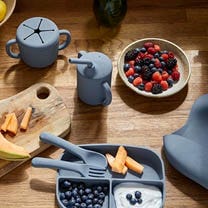Expert Tips for Parents
Babywearing
Expert Tips for Parents
March 18, 2025
There are so many wonderful benefits of babywearing. From supporting baby’s natural posture to reducing infant crying to strengthening the bond between baby and their caregivers and more, using a baby carrier is a win-win for you and your baby - emotionally, cognitively and physically.
But if you’ve never used a baby carrier, everything is new and unknown. So, you might be asking yourself things like what kind of ergonomic baby carrier should you use? When can you start using a baby carrier? Is a baby carrier safe for newborns? What about baby carrier safety and hip dysplasia?
Here are the basic things you need to know about using a baby carrier.
1. You can start using a baby carrier from day one.
So, let’s start with the question: is a baby carrier safe for newborns? Yes, if it offers the correct ergonomic support. With the right carrier or wrap you can even take it with you to the hospital and use it the day your baby is born. Using it in the early days and weeks is a great way to bond
Expert Tips for Parents
March 06, 2025
It’s a parenting right of passage, learning how to change a newborn nappy, but when you stand at the changing table for the first time and see this delicate creature lying in front of you, you may suddenly have doubts. It’ll become second nature soon enough, after all you’re going to have plenty of practice (8-12 times a day at the beginning!). And to help you feel even more confident, we've got a few helpful tips on how to ergonomically handle your baby while changing them, that will make it more comfortable for them and you.
What do you need to change your baby properly?
While this might not seem like rocket science, no one wants to find themselves in the middle of the changing process only to realise something is missing. Walking around with your half-naked baby in your arms is asking for trouble. So, having a checklist makes sure you’ve got what you need…
1. A safe space to change baby: Your changing table or changing station should be in a quiet and warm place. Always secure your
Baby Gear
Expert Tips for Parents
March 02, 2025
Do you have a little love who is incredibly curious and tries to see, understand and soak up as much of the world around them as possible? Do they constantly turn their head to the side when they’re in your baby carrier because there is so much to discover? If this is the case then they may be getting ready to face forward/outward (they mean the same thing). You can try it in any carrier that ergonomically supports this position, for example our Omni Deluxe baby carrier, and provided that your little one is ready.
How do you know if they are ready? They need to have reached the right size and stage of development, which usually happens around five - six months old. You can find out what else you need to know if you want to use an forward facing baby carrier in today's blog. When to carry your baby forward facing: the right time
Carrying your baby forward or outward facing is something you likely will do intuitively even without a baby carrier. As soon as your baby is around five-six
Baby Gear
Expert Tips for Parents
February 26, 2025
It’s official! A 100% recommendation rate, high ratings in key areas, and the ergonomic accolade from Aktion gesunder Rücken e.V. (AGR) campaign for healthier backs! The verdict is clear: our Ergobaby Alta hip carrier and Lift hip carrier are both loved by babywearing consultants, parents, their children and by us, of course. They are also the only baby hip carriers on the market designated “back friendly” by the experts at the AGR. But what else makes our hip seats so special and why are Lift and Alta recommended as baby hip seats by so many different experts?
The advantages of the Alta hip carrier and Lift hip carrier
If you have an active baby or toddler you will be familiar with being asked to pick them up then put them down then pick them up and so on and so on. The result: back pain, tired arms or other postural problems. If you keep lifting your little one up and sit them on your hip (without a designated hip seat), this takes its toll on your body: your spine is no longer in
Baby Gear
Babywearing
Expert Tips for Parents
February 20, 2025
There comes a time when your little love starts to feel heavy being carried on your front, even with the most ergonomic baby carrier around! And it can get tricky to see around them or bend down with them on your front. But you love exploring the world with them and you don’t want that to end. The good news is that it doesn’t have to. Because you can carry your baby on your back. And for quite a while yet. And we’ve got a whole bunch of reasons why we think you’ll both love an Ergobaby back carry, and exactly how to do it in a baby carrier like our Omni Deluxe. Because the end of babywearing is only in sight when the weight limit of your baby carrier is reached (20.4 kg for the Omni Deluxe) or when either of you no longer want to do it.
Requirements for carrying your baby on your back
To be able to carry your baby safely on your back, they should be able to:
demonstrate strong head and neck control
sit unassisted
weigh 17.2 lbs/7.8 kg
All babies are different but most will reach these
Babywearing
Expert Tips for Parents
February 11, 2025
It’s nearly time! Soon you'll be holding your tiny miracle in your arms and you probably won’t want to put them down for a second. And since your little treasure will feel most comfortable close to you, babywearing from birth is an easy choice. But which is the best newborn baby carrier? Or is it not a carrier at all - should you start with a baby wrap?
It’s probably not easy to answer this question. That's why we want to share what you should look out for when looking for a baby carrier for you to use with your newborn, and give you an overview of your options. With our help, it will hopefully be easier for you to find the best baby carrier for you.
Which baby carriers are suitable for newborns?
At Ergobaby, we attach great importance to ensuring that you and your little one thrive together in this whole new world. Right from birth. This includes supporting both physical and emotional well-being. And because we know that a newborn baby has very special needs, we have special ergonomic
Expert Tips for Parents
January 30, 2025
For the last twelve months, we’ve shared monthly installments of our blog series ‘Baby’s developmental milestones with Ergobaby: baby’s first year’, together with our midwife Katrin Ritter. We shared which baby milestones your baby will go through and when, what is important for healthy baby development in each month and what you can look forward to in the near future.
What was your most exciting or most moving milestone on the way from birth to the moment your baby took their first steps? Was it the first milestone in your baby's development, the first smile? Or was it the moment when your little one went into symmetrical hand support and they balanced themselves for the first time? Or the all-important milestone at the end of the ninth month: crawling? I’m sure you have an anecdote or two for every stage! We have a little reminder for you so that you can look back on all the big milestones:
Milestone (from the sixth week): The first smile
Milestone (6th-8th week): Beginning head
Expert Tips for Parents
January 20, 2025
Brrr, it is cold out there! Most days at the moment are cold, wet, stormy or even icy. And yet: you and your baby need fresh air: you need a walk to blow away the cobwebs, you need to take the dog out, or take older siblings to the playground… It's important that your baby - and of course you - stay warm and dry. A baby carrier is an ideal way to do this, as you can easily monitor your little one’s temperature and keep them protected from all weather conditions. However, there are a few things to bear in mind when wearing a baby carrier in winter to ensure that your baby gets enough air and doesn't overheat. For more information on how to dress your baby correctly in a baby carrier, see our top 5 tips for babywearing in winter.
But what if it's really hammering it down outside or you simply want some proper weather protection? Just to make sure that your baby's arms, legs and head are fully protected from the cold and wet... Then trust us when we say that a baby carrier cover is worth the
Expert Tips for Parents
January 14, 2025
One of the most common symptoms of pregnancy (alongside tiredness) is nausea or ‘morning sickness’. Most people experience some kind of sickness during pregnancy. Around 70 to 80 per cent experience nausea in early pregnancy, in the morning or throughout the day. Around half of those affected also experience vomiting (emesis) in addition to nausea. Some are completely spared this discomfort and others suffer from sickness beyond their first trimester. It’s most common during the first 12 – 20 weeks of pregnancy. After that, for most people, that queasy feeling usually subsides. But a small number develop a condition called hyperemesis gravidarum (HG) and suffer from prolonged and severe nausea and vomiting far beyond the usual ‘morning sickness’.
In today's blog article, with the help of our expert and midwife Katrin Ritter, we want to take a closer look at this often-debilitating pregnancy nausea. But perhaps most importantly we’ll be sharing some ideas for what might help you if you’re
Expert Tips for Parents
December 16, 2024
Congratulations! You've almost made it through the first year with your little miracle. With all the ups and downs. We know how quick it goes! Perhaps they are already taking their first steps. Or maybe they need a few more months? It’sall completely normal. Most children take their first free steps between the ages of 13 and 14 months, some walk much earlier and others only at 18 or 20 months. Everyone has their own pace of development. Today, let's take another look at baby milestones, focusing on 12-month baby milestones together with our midwife and expert Katrin Ritter. This concludes our blog series Baby’s developmental milestones with Ergobaby: baby’s first year. What can you already see? What can you look forward to in the near future? And how can you best support your little one so close to their first birthday?
12-month baby milestones: ‘The first step’
Your baby doesn't have to master free standing before they can start walking on their own. Some babies simply rush off because



















